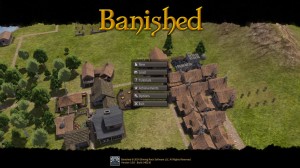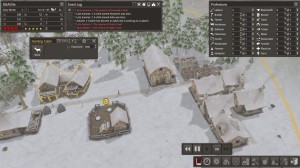I was doing incredibly well, or so I thought. I booted this sucker up for the first time at 7 PM and before I knew it, I had a fairly happy and successful little village going. Not bad for having no knowledge of the game prior to playing it…I guess I really am a true games “journalologist” (HA!). Around 9:30, all of that went downhill when my population starting dying off one by one due to old age. To my dismay, I discovered that my villagers hadn’t produced enough children to replace those dropping like flies. Apparently, couples are hesitant to conceive children when being crammed into a house already occupied by three complete strangers…who knew? Essential buildings were now vacant, resources were starting to dwindle as a result…needless to say, I was a sad little panda when I realized that I had a serious problem. Such is the way of “Banished”.
“Banished” is not exactly the first name I’d pick for a “city-builder” of this type…though it does tie in with the story, what little there is. Essentially, you’ll choose some map parameters and be thrust into a world with only a handful of people and resources. These people were once exiled from whence they came (hence the name) and it’ll be your job to build them a new home. While I used the term “city-builder” earlier, it’s really a “village-builder” as your population really doesn’t grow to meta proportions. I never saw anything past forty adult villagers in my first playthrough, but more on that later.
As far as the nitty-gritty details are concerned, “Banished” is a single player game through and through. The main menu will allow you start a new game, continue an existing one, check out tutorials, view achievements, and adjust game options. The options menu covers your basics and then some, like screen resolution, graphics quality, audio volumes, vsync, fullscreen, keybinds, auto-save timer, and etc. Starting a new game will bring up a small box that allows you to customize your experience by way of difficulty, terrain type/size, climate, disasters (on/off), and etc. You’ll also be able to name your village and choose a particular map seed, if you so desire. Overall, a fully functional menu system.
Getting back to the “village-builder” bit, “Banished” isn’t a game that will rival the grand scale of say, the “Anno” or “SimCity” series. In both “Anno” and “SimCity”, you’ll be doing your darndest to build a city of epic proportions, growing your population in some cases to over a million citizens. In “Banished”, there’s heavier emphasis on micromanaging the individual than in building a vast empire. You won’t have to tell each villager when to sleep or poop mind you, but you will be changing their assigned tasks from time to time as the need arises. The closest comparison to “Banished” I could come up with (that I’ve played) is “Caesar IV”, a game I hold dear to my heart. “Caesar IV” is heavy on resource micromanagement and “Banished” can be just as demanding at times.
Gameplay is challenging, but satisfying. The interface is pretty fluid in that you can call up various windows and move them around the screen. Some windows allow you to quickly assign workers to tasks while others serve as read-only reports or event logs. In terms of a tech tree, there isn’t one. You’ll have access to every building from the start, though you’re limited to what you can build as they each have varying costs. It’s also important to emphasize that there is no “money” in this game. When I say costs, I’m referring to the material you chop, mine, craft, and etc. The marketing and trading done in this game, as a result, is accomplished mostly through barter. You can “buy” scarce resources from traders once you get that far, and you probably should. The map in which you start is randomized and won’t have everything you’ll need to support larger populations (livestock, seeds for farming, etc.), at least, not easily.
There are roughly twenty different professions for your villagers to fill and it’s a constant struggle to find the right balance. Sometimes food harvests might be low, forcing you to assign villagers away from mining and woodcutting to fishing or hunting instead. But wait, winter is coming, and your villagers will need firewood to heat their cabins. You’re also running low on coats and there’s still not enough housing to shelter your villagers. This all wouldn’t be a problem if you had fifty villagers at your disposal, but the ten or fifteen you have at present is all you got. Why not just put the children to work, you ask? Children don’t do much except drain resources, but are essential in replacing villagers as they grow old and pass on…decisions, decisions!
In terms of a learning curve, I will admit that the game does take a few hours to get a handle on. I was constantly tweaking my workforce and moving people around to different tasks in order to make sure that my storage piles didn’t run dry. With that said, I was comfortable with how everything worked and was even prospering for a while just after a half-hour. It’s not that the game is difficult to play, it’s just that it’s easy for one bad thing to snowball into three other bad things, which in turn snowballs into a situation in which you have no chance of recovering. This game will require your constant attention, especially if you speed up the game to 5 or 10x. Learning the game’s mood swings is where the real challenge lies and I admit, it can be both fun and frustrating to watch all of your hard work go belly up over something you didn’t expect.
My only real complaint is the music, which I feel could be a bit more Celtic and less Techno, for lack of better term. There are only a few music tracks and they really aren’t consistent with the era involved, I feel. I eventually just turned the in-game music off and booted up music from my own collection…you wouldn’t think that the “Warcraft II/III” soundtrack would work here, but it surprisingly does. Everything else, from the menus to the interface and gameplay, are all satisfying in their own way. Some may gawk at the lack of combat or a tech tree, but I was too busy worrying about the elements and micromanaging my villagers to care.
I’ve opted to leave a lot of the gameplay functionality out of this review, as some of the fun in playing this game is derived from discovering these things on your own. With that said, the ability to micromanage is an essential part of playing “Banished”. If you prefer city-builders that are more relaxed to where you can hit the fast-forward button and let the game play itself, “Banished” may not be ideal for you. You’ll thrust your fist up in satisfaction when your storage barn fills with food, and cry when you realize that your last tool broke and you haven’t even constructed a blacksmith yet in order to make more. It’s a hell of a rollercoaster, I’ll give it that…well worth the twenty bucks I paid to add it to my ever-growing collection.
Final Verdict: 9/10
—
You can learn more about and purchase “Banished” by visiting the following websites:
http://store.steampowered.com/app/242920/
http://www.shiningrocksoftware.com/
—
http://www.youtube.com/watch?v=eus1A5U_9Eo
http://www.youtube.com/watch?v=ZiMLNezZwgU


